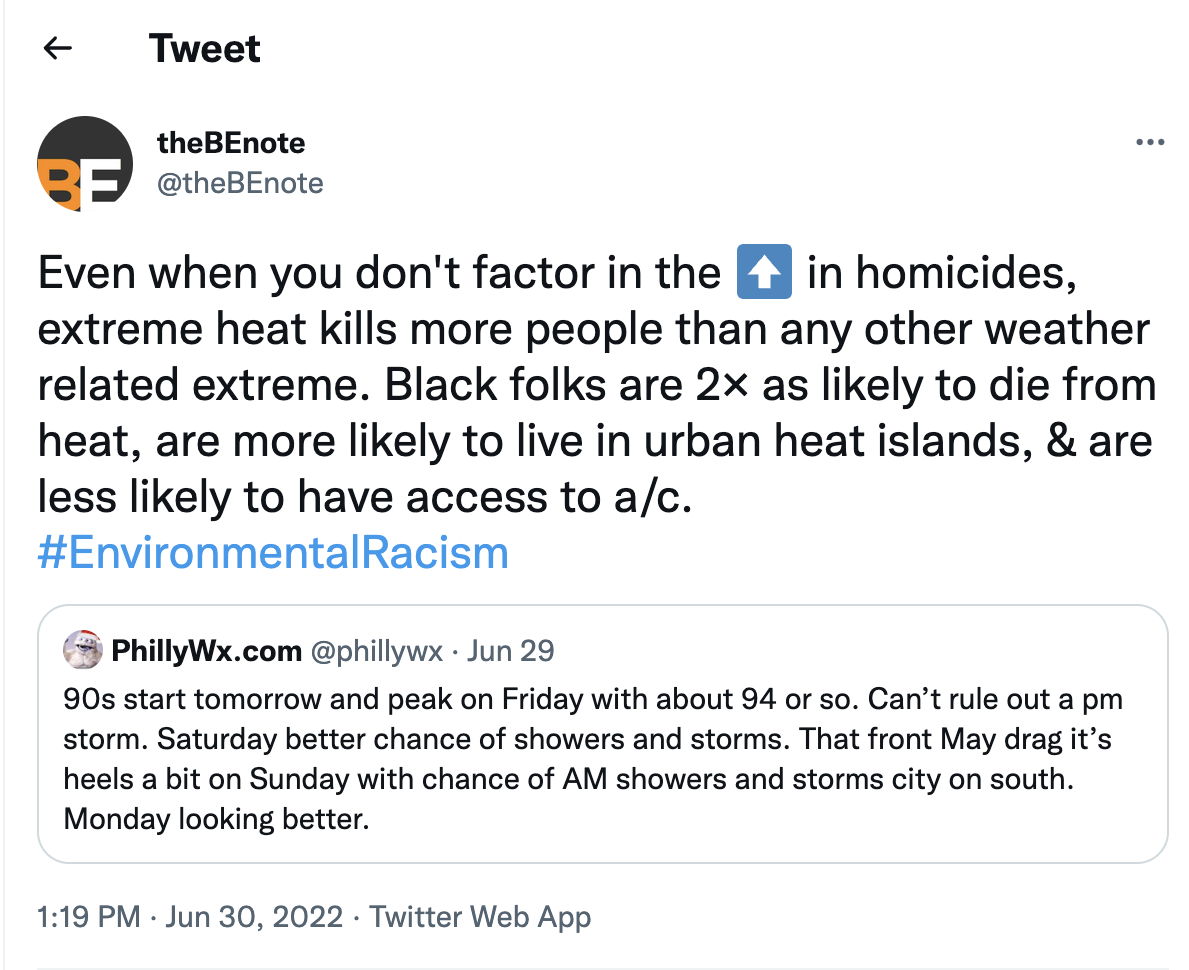By Charles Ellison
Urban heat islands are deadly. Do you live on one? If you’re low-income and Black in Philadelphia, it’s pretty likely that you have been redlined into an urban heat island (UHI).
UHIs occur when cities become hotter than their surrounding areas. Neighborhoods within cities also can become urban heat islands when their temperatures rise. But how do you know if you live in one?
When it’s hot, does it feel like your neighborhood is even hotter compared to another neighborhood you happened to go to, shop in or catch a SEPTA bus through? If it does, you’re probably living in an urban heat island. UHIs tend to be two to seven degrees hotter than the surrounding areas — and sometimes even hotter than that. They also don’t cool down at night.
The reason UHIs don’t cool down at night is because they predominantly occur in areas where cement and asphalt dominate the landscape. These materials absorb heat and hold on to it, so while other neighborhoods cool down in the evening, UHIs don’t. Look around your block. What are the buildings and grounds made of? If all you see is cement, brick and asphalt, you probably live in an urban heat island.
Keep looking around. Do you see any trees? Gardens? Water features? If you don’t, you’re probably living in a UHI. Trees provide shade to people, as well as shade for pavement and buildings. They also remove heat from the air. By planting trees, the temperatures of people and infrastructure can be brought down, reducing the threat of an urban heat island.
Gardens also can provide open spaces where air can flow while absorbing heat from the atmosphere. If your building has a black tar roof, it is going to absorb the heat and increase the temperature of the entire building. If, instead, you had a garden or a full set of shrubs planted on a rooftop, they could help cool the entire building. If your building has a black tar roof, you’re probably paying a higher electricity bill trying to cool your place, too … and that’s if you have air conditioning.
People that live in urban heat islands are usually forced to pay for cooling themselves, but there’s a lot that the city of Philadelphia can do to reverse the causes of urban heat islands, cool communities, reduce the cost burden to residents — and reduce violent crime, too.
In addition to planting trees and gardens and installing cooling infrastructure like water features, cities can use lighter color cement when paving and repaving roads. Using lighter colors will prevent roads from absorbing as much heat. With less heat absorbed, the temperatures can go down. The city also can spray streets with water on hot days. This is a technique used in Japan. Another technique that can be used to cool UHIs is to paint buildings with reflective paint that can prevent heat absorption and keep temperatures down.
The city of Philadelphia also can pass legislation that requires landlords to ensure apartments maintain livable temperatures. There is a policy that requires landlords to keep their units above 68 degrees in colder months. There is no policy requiring them to keep their units cool, though. These efforts can be coupled with programs that help landlords install solar air conditioning units so tenants can keep cool without adding to the larger climate crisis. Solar panels also can be used to keep schools cool and supplied with clean energy. At a time when schools in Philadelphia are closing because they can’t keep students cool, these solutions also can be effective in helping to keep the education system functioning.
Imagine a hot summer day in your neighborhood. Now re-imagine that same day if your home had functioning AC. Imagine if there was a garden on top of your roof and trees planted outside. Imagine a cool breeze flowing down your block. Imagine lower electricity bills, less violence and a higher quality of life. We can eliminate urban heat islands and live more comfortably by making these very simple investments in our neighborhoods now.
What We’re Reading:
- Heat Vulnerability Index highlights City hot spots | Department of Public Health | City of Philadelphia
- Ask a Scientist: How Can We Cool Off Urban Heat Islands and Protect the Most Vulnerable? – Union of Concerned Scientists (ucsusa.org)
- Cool-colored coatings fight the urban heat-island effect (spie.org)
- Using Green Roofs to Reduce Heat Islands | US EPA
- Using Trees and Vegetation to Reduce Heat Islands | US EPA
Quote of the Week:

Did You Know … ?
The amount of solar at K-12 schools in Pennsylvania doubled since 2020, according to a new statewide report on schools’ adoption of solar published by Generation180, a clean energy nonprofit. Read the full article here. [LINK: New report finds solar on Pennsylvania K-12 schools doubled since 2020]



